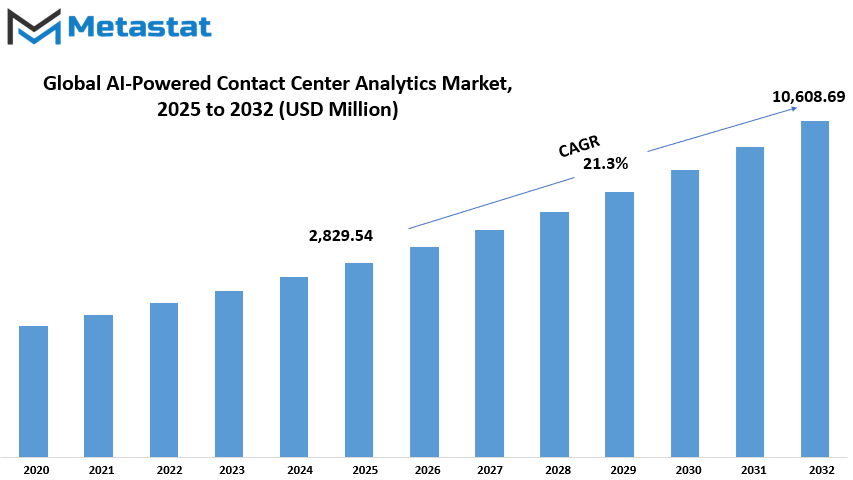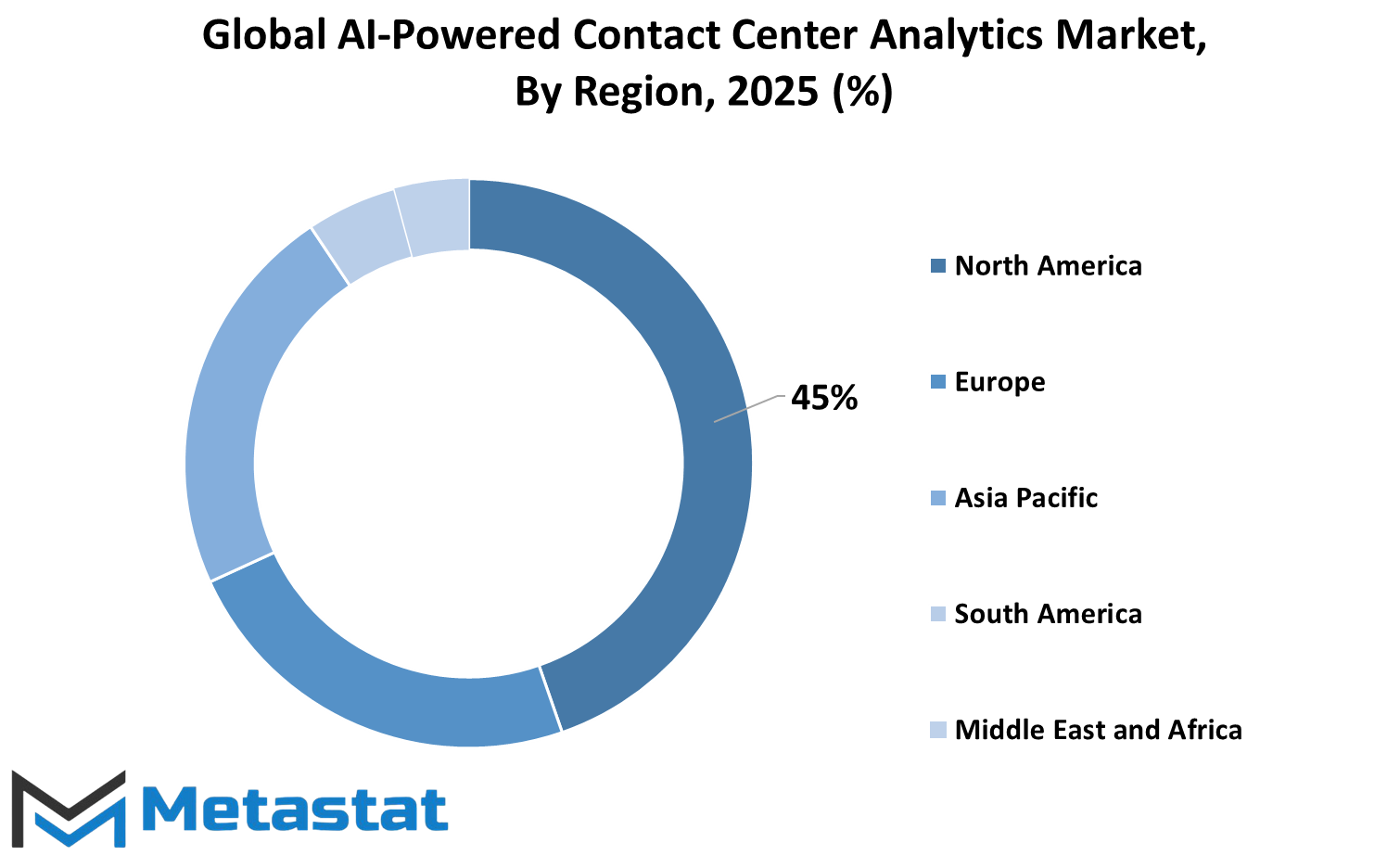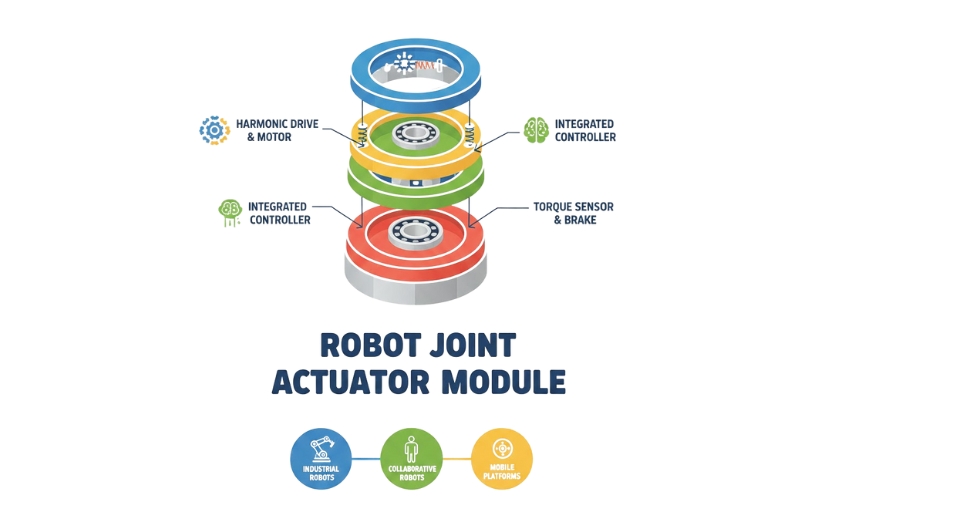MARKET OVERVIEW
The Global AI-Powered Contact Center Analytics market shall continue to diversify its offering in fulfilment of diverse operational requirements. Companies in industries that handle huge inquiries cannot afford to limit themselves to mere standard performance tracking tools. AI-powered solutions present the opportunity to assess agents' efficiency, track compliance with service protocol in real time, assess customer sentiment, and do all this concurrently using real-time insights to support improvement of service delivery and insight into anticipating customer needs and adjusting to suit.
AI Powered Contact Center Analytics using AI has carved out a huge place for itself in business intelligence and customer service in the Global market, in providing complex tools to analyze a large bulk of communication data in detail. The key focus of the market would be the enhancement of customer interactions using AI, improving agents' performance, and extracting meaningful insights from voice, text, and digital conversations systematically. As organizations are set on customer experience nowadays, admittedly AI analytics in contact centers will help in merging the workflow together with improved decision processing.
The paradigm is that manual analysis and basic reporting tools were used in the past for any contact center work; data analytics with the introduction of AI has introduced a whole new dynamic in that context to deal with the real-time analysis of complex data. The Global AI-Powered Contact Center Analytics essentially deals with technological applications to transcribe, classify, and evaluate customer conversations, achieving accuracy never presumed within the boundaries of traditional systems. These systems identify trends, recognize patterns, and detect inefficiencies in the operation through the application of machine-learning methods, natural-language processing, and sentiment analysis. As the phase of human intervention come to an end through automation, organizations shall find themselves in a more favorable position to strategically implement decisions based on comprehensive reporting and predictive intelligence.
Security and compliance will be the main drivers for the market in such a climate, as organizations deal with different data privacy laws from across the globe. AI analytics platforms will secure customer-sensitive data from unauthorized use while remaining compliant with relevant laws and industry regulations. Automated monitoring and fraud detection would be fundamental to keep customer interaction secure while giving organizations the means to counter security threats. AI solutions, in turn, assist organizations in adopting a systematic approach to compliance management, with the objective of fostering transparency and accountability.
Global AI-Powered Contact Center Analytics market is estimated to reach $10,608.69 Million by 2032; growing at a CAGR of 21.3% from 2025 to 2032.

GROWTH FACTORS
The Global AI-Powered Contact Center Analytics market is anticipated to witness enormous growth owing to the increasingly personalized nature of customer experiences and the adoption of such advanced technologies. Companies utilize data-driven insights to build better service-oriented solutions to enhance the relevance and engagement factor around customer interactions. This personalization process is no longer just a passing trend but rather a measure in response to consumer service expectations around being adequately serviced and having their needs understood.
Artificial intelligence and machine learning, in particular, have made their presence felt in real time; hence analysis of customer sentiment takes the front stage in this transformation. By interpreting emotions and feedback in interactions during any engagement, businesses can act quickly to ensure customer delight, satisfaction, and loyalty as required. With this, simultaneous tuning of strategies could be possible to keep evolving customer service in a way that is always responsive and effective.
However, despite these opportunities, there are challenges that hinder the process of AI analytics integration in the contact center. The cost of setting up these sophisticated systems might be prohibitive, and this may also speak to some organizations' hesitations to integrate them into their home-grown infrastructure. The other pressing issue is, however, data privacy and security, as any of these solutions analyze customer data; these solutions carry very high feasibility and vulnerability for keeping sensitive information. However, overcoming these challenges is the essence of companies with good reputations and working within the regulatory framework.
Another exciting opportunity is the proliferation of AI analytics for any communication channel. Through a unified view, customer interaction gives organizations insights into customer behaviors and preferences. This allows the design of optimum engagement strategies, which further strengthen the business-customer bond. AI has a promising road ahead for improving customer service interactions in new ways. This opens up an exciting world of engaging interactions that offer efficiency and meaningfulness
MARKET SEGMENTATION
By Deployment Mode
AI-Powered Contact Center Analytics Market are witnessing steady growth with organizations looking for better methods to understand customer behavior and enhance the services. These analytic tools use AI that equip companies to track, measure, and study conversations across multiple platforms like call, email, chat, and social media. This way, companies can get to know certain trends, understand customer needs, and make more informed decisions to improve upon their service level. The market is driven by increased demand for rapid and accurate responses, improved customer experience, and optimal utilization of customer data. More and more companies are now beginning to acknowledge the value of these tools in not only fixing existing problems but being able to predict them before they happen.
Apprehended according to the means of application, the market is classified into two paradigms, namely, On-Premises and Cloud-Based processes. The On-Premise segment has a valuation amounting to $845.75 million. In this option, the company has complete control over the data as everything is internally stored and managed on their own servers. This is the most widely adopted route for businesses focusing on very tight database security and are companies that have their own IT infrastructure already in place, although it can be an expensive option both in cost and time for implementing. Besides the high cost and long deployment time, it requires maintenance to keep the system running, which needs the presence of an IT skill team to troubleshoot on updates and any issues. Slightly due to its challenges, there is a strong preference among companies to deploy On-Premises due to the aspect of control and privacy.
On the other hand, Cloud-Based deployment enjoys massive implementations due to its flexibility and lower upfront costs. Instead of the purchase or upkeep of hardware, companies make use of software hosted online. This means that the setup can be done in no time, easy to do updates, and if the system is wanted to be accessed by anyone instants after its activation, it can be activated with ease. For growing businesses or those with remote teams, this can be a massive advantage. Another benefit that Cloud-Based solutions offer is ease of scalability, thus letting companies adjust their services as and when needed with no major changes or expenses involved. The convenience of using the Cloud makes it appealing to a lot of businesses, especially small ones or those unfamiliar with AI-powered tools.
In conclusion, a company adopts either mode of deployment, depending on the benefits to its needs, resources, and priority. As technology advances, more organizations are likely to take this decision in favor of some technology that enhances their workflows while considering customers to be heard, understood, and satisfied.
By Component
The Global AI-Powered Contact Center Analytics Market will bring about a remarkable transition in customer-interaction processes. With the rising sophistication levels of AIs, companies will exploit AI-enabled analytics to gauge customer needs, formulate service standards, and optimize operations. Organizations are now pursuing avenues of smarter ways to analyze customer conversation trends, predict behavior, and bolster engagement strategies. The AI analytics journey is more than just organizing vast amounts of data; it is really about transforming those insights into intelligent decisions that foster efficiency.
Organizations will require capabilities to analyze conversations in real-time and offer relevant feedback with personalization as the criterion. AI will enable analytics to gauge customer sentiment, learn trends in conversations, and proactively suggest solutions for issues that repeat. Such proactive anticipation would ensure a soaring higher level of customer satisfaction, and of course, brand loyalty will hinge onto it. Companies utilizing AI-enabled analytics will gain competitive advantages by enabling faster operations and leveraging logical decision-making to counter their rivals.
The rapid growing trend in AI-driven adoption across various domains seems now to have broadened the Global AI-Powered Contact Center Analytic market. Businesses are realizing the efficacy of automation and intelligent analytics on customer support systems at large. AI tools would keep on getting smarter with evolving functionalities, including multilingualism, refined speech recognition, and sentiment analysis, that will give birth to business needs across varying customer needs ensuring seamless communication across regions and languages.
This market, by composition, is divided between solutions and services. Solutions represent software applications to study interactions, gauge sentiment from customers, and optimize workflows. These tools will, in a long run, be advanced enough to partially or totally automate complicated processes with human-like interventions concerning customer interactions. Services should focus on consulting, implementation, and support in embedding AI analytics into pre-existing organizational ecosystems. The demand for both kinds of offerings is expected to rise as more and more companies go through digital transformation, with AI analytics being an indispensable part of modern-day contact centers.
In the session ahead, AI analytics will present noteworthy factors towards efficiency and operational cost savings. Human agents are freed up from repetitive tasks by automation to deal with complex customer problems. Today in AI, analyzing terabytes of data forms the basis of faster decision-making due to quality service by the different innovations in customer care services in the coming times.
By End-User Industry
The Global AI-Powered Contact Center Analytics Market is all set to sweep the grounds of shuffling customer interaction experience across different industries. Artificial intelligence will ease understanding businesses with deep insights into customer behaviors, smooth operations, and changes in service quality. The early demonstration is seen across all sectors. Each sector has been adopting AI analytics with the aim of solving different challenges and realizing opportunities.
AI analytics plays a major role in transforming customer interaction management from an omnipresent contagion menace paradigm into a control master model for the BFSI sector. Monitoring conversations, discovering patterns, and improved customer service delivery are all advantages that such tools can bring to financial institutions. These analytic solutions are beneficial in reducing risk and affording avenues for regulatory compliance since compliance and data security have larger, underlying drivers.
The IT and telecommunication industry use the massive volume of customer support queries for the application of AI-enabled analytics. It enhances the monitoring of performance metrics, optimizes the agents' schedule, and offers prompt support services. When combined with the incumbent systems and enhanced service strategies, it gives a holistic view when it comes to customer interactions.
AI analytics may involve preference understanding and thereby ensuring the experience of a customer in the aspect of retailing, e-commerce, et cetera. Retailers will personalize communication using it, predict needs, and enhance loyalty through understanding and interpreting all communications through a seamless customer journey made possible via online integration with these analytics across different touchpoints.
Many healthcare organizations are embracing AI analytics to facilitate not only patient engagement but, even more so, operational efficiencies. Call centers in healthcare-oriented organizations exhibit different activities-for instance, appointment-making, providing medical information, and other queries. Furthermore, many analytical tools provide comparisons between patients visiting for healthcare purposes, especially with regulatory compliance incorporated into the healthcare context, which, again, captures better service delivery regarding patient satisfaction.
Manufacturing may utilize AI analytics to respond to customers' support/inquiries and make internal communications more efficient. Interaction measurements spell out system-wide problems, reduce downtime, and generally improve product quality. Hence, operations run a lot more smoothly, combined with an understanding of customers' needs.
This way, AI-driven analytics are employed by governments in improving public service delivery. Their call centers field countless citizen inquiries; these analytics assist in monitoring performance and key performance indicators and pinpointing areas for potential improvements. This results in a better citizen satisfaction outcome while optimizing resource use.
|
Forecast Period |
2025-2032 |
|
Market Size in 2025 |
$2,829.54 million |
|
Market Size by 2032 |
$10,608.69 Million |
|
Growth Rate from 2025 to 2032 |
21.3% |
|
Base Year |
2024 |
|
Regions Covered |
North America, Europe, Asia-Pacific, South America, Middle East & Africa |
REGIONAL ANALYSIS
The establishment of a whole new generation of AI-Powered Contact Center Analytics Market comes with the adoption of AI in customer service. Customers in region after region have successfully benefited from AI for analyzing customer interactions for response time and service quality optimization. Increased automation, enhancing customer experience, and data-driven decision-making have supported the growing demand.
North America continues to dominate with rapid technological advancements and bulk adoption of AI in industries like finance, health, and retail. The US remains the hub for AI trends breaking new grounds, with major investments in AI analytics from corporate houses. AI contact center analytics find a conducive environment for growth in Canada and Mexico, where these markets are embracing predictive analytics and automation to cut time on customer interactions. Being home to quite a few established players and possessing excellent digital infrastructure is a big reason for its compiler to be a stronghold in the industry.
Europe witnesses slow adoption of AI for different kinds of analytics. The UK, Germany, and France are encouraging examples of introducing AI in contact centers in the more customer-oriented manner. Within this region, organizations employ AI for efficient operations, customer sentiment analysis, and personalized customer support. Data regulations such as GDPR also significantly affect the strategic planning of AI concerning analytical tools meeting these compliance requirements. The balance struck here between forward-looking technologies and data privacy concerns ought to become one of the strong drivers for AI analytics.
Asia-Pacific is emerging as one of the most important markets of AI-powered contact center analytics, with prominent players being China, India, Japan, and South Korea. Rapid digital transformation and the expanding e-commerce sector have increased the market across these continents. Organizations are using AI to gain insightful information from gigantic data on customer behavior, which can then be used to improve service and optimal resource distribution. Increased acceptance of cloud-based solutions and the AI-enabled chatbot service facilitate market growth. Given that companies continuously invest in digital technologies, the demand for AI-enabled analytics services on the secondary level is expected to rise rapidly.
In South America, AI adoption for contact center analytics is somewhat lagging, with Brazil and Argentina being predominant players in this markets development. Enterprises find themselves increasingly keen on probing the capability of AI to boost customer satisfaction and operational efficiency. The acceptance level is low compared with others, but a fresh surge of awareness toward cutting-edge technology may bring them back in competition.

COMPETITIVE PLAYERS
In the AI-Powered Contact Center Analytics Market, distractions exist no longer to help companies search for enhancements to their customer satisfaction effort and general productivity. Such technologies empower companies to analyze conversations, find trends, and glean insights into customer requirements. Businesses can then make informed decisions to enhance customer satisfaction and streamline their team's workflow. The competitive armada is getting bigger and more organizations are opting to use these tools to match demands.
The key players in the AI-powered contact center analytics market are Verint Systems, NICE Ltd., Afiniti, Microsoft Corporation, Salesforce, Teleperformance, Google Cloud, Amazon Web Services (AWS), IBM Corporation, Zendesk, Five9, and Talkdesk. These vendors offer sophisticated products that convert every customer interaction into meaningful insights. Businesses can quickly assess their customer experiences and measure agent performance using real-time speech analytics, sentiment analysis, and automatic transcription.
One of the main reasons for growth in this market is the save time and effort due to lack of manual work. In earlier days, it would take hours to review a call recording or customer message. AI now scans data and puts it in order in a matter of minutes, allowing managers clear visibility into common challenges for the customer, how well agents are responding to them, and where improvements are needed. It also assists them in identifying training needs, script improvements, and optimized resource allocation.
Yet another factor drawing businesses toward AI-based analytics is the rising demand for personalized services. The customers now expect a prompt, accurate, and pertinent response. AI solutions empower businesses to meet such expectations by enabling agents with relevant information at the right time. The end customer thus finds a better service and the agent finds his job easier and less stressful.
Security and data privacy serve as complementary areas in this market. The leading competitors ensure full compliance of their tools with laws, guaranteeing maximum protection of customers' details. Thus, trust is being built, and businesses are able to implement these technologies with confidence.
With AI-powered contact center analytics fundamentally transforming the ways companies understand and serve their customers, supported strongly by important players in this industry and increasing demand for smarter services, this market is on the path of further growth and importance in the near future.
AI-Powered Contact Center Analytics Market Key Segments:
By Deployment Mode
- On-Premises
- Cloud-Based
By Component
- Solutions
- Services
By End-User Industry
- BFSI (Banking, Financial Services, and Insurance)
- IT and Telecom
- Retail and E-commerce
- Healthcare
- Manufacturing
- Government
- Others
Key Global AI-Powered Contact Center Analytics Industry Players
- Verint Systems
- NICE Ltd.
- Afiniti
- Microsoft Corporation
- Salesforce
- Teleperformance
- Google Cloud
- Amazon Web Services (AWS)
- IBM Corporation
- Zendesk
- Five9
- Talkdesk
WHAT REPORT PROVIDES
- Full in-depth analysis of the parent Industry
- Important changes in market and its dynamics
- Segmentation details of the market
- Former, on-going, and projected market analysis in terms of volume and value
- Assessment of niche industry developments
- Market share analysis
- Key strategies of major players
- Emerging segments and regional growth potential








 US: +1 3023308252
US: +1 3023308252






